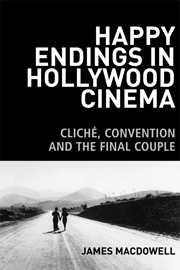1 - The ‘happy ending’ and homogeneity
Published online by Cambridge University Press: 05 October 2013
Summary
In an ideal world the central argument advanced by this chapter would not require making. Yet, such is the weight of reputation that it seems the necessary place to begin. This chapter is, first and foremost, concerned to question the existence of the ‘happy ending’, that is: a homogeneous, clichéd ending, which recurs consistently across the majority of Hollywood movies. This is a separate issue from the existence of ‘happy endings’ – a broad category of conclusions that (according to criteria yet to be defined) ‘could be said to end happily’ (Bordwell 1986: 159) rather than ‘unhappily’. Thus, while this chapter interrogates the usefulness of the category the ‘happy ending’, it will also suggest some productive means by which we might identify a ‘happy ending’. The distinction between the two might seem pedantic, but for an academic discipline it should not be insignificant. Conjuring up images of a ruthlessly repetitive, production-line approach to filmmaking, to use the term ‘the happy ending’ is to lend immediate credence to the kinds of critical generalisations we encountered in the introduction. This rhetorical strategy is exceedingly common in film studies, and is even repeatedly employed in Neupert's The End: Narration and Closure in the Cinema (1995: 40, 71, 72). If the term the ‘happy ending’ and the concept to which it refers have critical validity, then the ‘happy ending’ should be able to be defined —and, we might imagine, rather easily so. This is a task attempted by this chapter.
- Type
- Chapter
- Information
- Happy Endings in Hollywood CinemaCliche, Convention and the Final Couple, pp. 19 - 56Publisher: Edinburgh University PressPrint publication year: 2013



